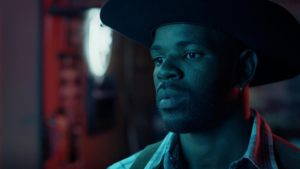1. Use Drama to Create Comedy
To Strouse, comedy is our commentary on life. “Real life is very rarely dramatic or comedic. Life is usually rooted in a lot of suffering and pain, but it’s our perspective and commentary on it that makes it funny.” Throughout her class, she gives examples of scenes that are quite dramatic and yet are made funny by the commentary that is created. For instance, Strouse shows a clip from A League of Their Own where two sisters are fighting while many other characters are eavesdropping outside the room and hilariously trying to figure out what is going on inside. Strouse highlights the sense of relief created by their conversation, because, as an audience, we are also eavesdropping on this personal moment and trying to figure out what is going on. Without the funny commentary, it would instead be a pretty intense scene.
Beyond the sense of relief, Strouse also believes we connect to comedy because, “It actually makes us feel closer to other people.” She discusses this in terms of stories as mirrors and windows, allowing us to both see our own lives in the characters and peer into someone else’s life. In relation to the clip from A League of Their Own, Strouse explains, “I think you see yourself in the sisters and you say, ‘Oh my gosh, I have felt like that with my sibling or my mother. I’ve had those feelings.’ Then the other part is you saying, ‘Oh, that’s not me. I would never fight with my sister like that,’ or ‘Thank god that’s not happening to me right now.’ It gets you to be both very close to the people on screen and very close to the people in the audience, depending on which role you’re assuming.”
Another thing to keep at the forefront of your mind as you approach comedy is its connection to the darker aspects of the human experience. To explain this, Strouse delves into Finding Nemo. She teaches, “While it’s a comedy, it actually opens with a mass murder. Then, a child is born with a disability. Then, there’s a man with what you could probably consider a mental disorder, and then, a kidnapping, not usually the kinds of things you think of when you think of comedy, but I would argue that that’s exactly what you need to be thinking of when you’re thinking of comedy.” You should be considering these intense, real-life moments because when, “We see something in life that’s dark and painful, we talk about it; we comment on it; we have a perspective on it.” By reflecting on hardship in this way, we create the sense of relief and in doing so, the darker aspects of life become fertile ground for comedic moments.
The thing to keep at the forefront of your mind when you're writing is: who is this person? What do they want in every single scene?
Victoria Strouse Tweet
2. Focus on Truth and Specificity
Strouse believes you cannot have comedy without truth and specificity. However, it may not be your natural instinct to write with these in mind. Reflecting on her own experience, Strouse believes that funny people often tell jokes as a way to get approval, and to feel loved when people laugh. Likewise, as a comedy writer, “It feels like, if you’re looking for love, you should do the pleasing thing; you should tell the pleasing joke. And, the thing you constantly have to remind yourself is that’s not how you get the laugh. You might get a smile; you might get a pat on the head, but it’s the bravery to take it to that next level and really be truthful and specific that’ll get you there.”
Strouse acknowledges that telling the truth in life is not easy, even to oneself. There is usually a lot of pain, disappointment, and fear in telling the truth, and yet, “It’s actually the thing that gets you to what is funny.” To be vulnerable in this way, you will probably repeatedly have to ask yourself, “Tonight did I just write something pleasing, or did I write something true?” In the combination of specificity and truth, the comedy comes to life in unexpected and hilarious ways.
As a compelling and comedic example of truth and specificity, Strouse shows the clip below from A League of Their Own.
Analyzing the clip, Strouse argues that what “makes it so effective is that this is not somebody who’s just saying, ‘Hey, you messed up.’ He gets to the truth for him, which is, ‘There is no crying in baseball,’ and it infuriates him. The thing that has made the scene iconic and made us all laugh at it, even though it’s incredibly harsh—they’re actually really fighting, and she’s crying—is that he is telling his truth and he’s being so specific.”
3. Develop your Characters’ Strengths, Weaknesses, and Desires
Strouse emphasizes, “Character is at the heart of all good comedy. Whether it’s Three Stooges, physical comedy, or Shakespeare, character and what a person wants and needs, which are two different things, are so vital and drive every comedic moment in every movie.”
On their journey to get their wants and needs met your character has recognizable, “strengths which allow them to move forward successfully through the story, and weaknesses which usually set them back.” These strengths, weaknesses and desires help constitute the core of your character, so “The thing to keep at the forefront of your mind when you’re writing is: who is this person? What do they want in every single scene?”
This want, however, should not be achieved in every scene because, Strouse explains, “What makes good drama and good comedy is very similar; somebody wants something, and there is something in their way.” Dynamic comedy obstacles can be anything from a neurotic, narcissistic mother like in Flirting with Disaster, or a tiger that just woke in the backseat of your car like in The Hangover.
As a writer, you need to ask yourself, if the character succumbs to the obstacles and is unable to attain their wants, what will happen to them? What is at stake for them? Strouse stresses that these, “Stakes are extremely important in comedy. The stakes don’t have to be life or death, and they don’t have to be every single moment. In fact, if the stakes are too high in every moment, comedy can feel manic and manufactured. So you want to be aware of when and how to use stakes, but it’s also very important for your story that something is at stake for the characters, for their well being, for their world.” It is also important to keep in mind that it should feel to the audience as though your protagonist has the most at stake in your story.
Out of these wants, needs, and stakes, a foundation for strong comedic moments can be created. To illustrate this, Strouse shows the first minute or so of the following clip from Broadcast News.
In Strouse’s analysis of the scene, she asserts, “The reason it’s so funny when we’re watching her run and jump over a baby, is because we know what’s at stake for the characters…so we’re able to really, really laugh and enjoy her insane trip.” Strouse recalls her explanation of the “mirrors and windows” that comedy provides. “That’s one of the reasons we’re laughing because we’re going, ‘Oh my god, I’ve been there,’ which is the mirror and the window is, ‘I’m so glad that’s not happening to me right now. That’s happening to her. That’s not me.’ And it’s a tremendous, tremendous relief.”
4. Capitalize on Character Relationships
Strouse presumes that, “Probably any comedy that you can think of has at its heart a central relationship. Whether it’s with an ally or a foe, it is what drives the characters’ progress, journey, and setbacks. It’s a great reflection of who they are.”
A common example of this is a buddy comedy. Usually, these films have two wildly different characters who are thrown together to achieve a shared goal, despite their opposition to working together. The differences between them illuminate their individual strengths and weaknesses, and create a foundation for comedic moments. All that said, being stuck together is usually what prompts the characters to grow; Working together is not what they want, Strouse says, but “It’s usually the [opposite] character who’s going to get them what they need.”
Writing this sort of relationship can be complicated because you need to be subtle about the growth and bonding between the characters. Strouse explains that, to do this effectively, the relationship has to have its own believable arc that builds over the course of the script. Her advice is to study the many effective tropes that these buddy comedies films use to do this.
5. Say as Much as You Can, with as Little as You Can
“A great screenplay scene usually has about three to ten things going on. You’re learning about character, story, a setup or a payoff of a joke, an aftermath from a previous scene, or a development in a relationship.” This myriad of things happening in a concise and simultaneous way is what Strouse calls efficiency and layering. To Strouse, this “is probably the most important technical component of screenwriting, whether it’s drama, comedy, or any genre. It’s the hardest and it comes in draft ten or eleven, really at its peak, at its finest.” She assumes that even the greatest comedy scenes were at one point multiple scenes or a clunky long one, but through a process of revision, they were sculpted into final form.
She also stresses that, “Great writing uses the least amount of words, the least amount of screen time to get a point across,” suggesting that, when fitting, you want to employ visual storytelling rather than dialogue. If you do need to use exposition, think of how you can weave it in cleverly without removing the audience from the story. One tactic Strouse suggests is to use intriguing, secondary characters who are important in some way to the story of the main characters as a way to work exposition into the story.
The scene below from A League of Their Own weaves exposition in effectively.
This is an example of a secondary character who “gets out quite a lot of information: Harvey Bars is starting a professional league; The tryouts are in Chicago; They’re looking for pretty girls; The girls are getting paid $75 a week. We learn a lot in that scene, but again, it’s so beautifully disguised.” Strouse goes on to explain, “There’s also a lot more. We’re also learning more about the sisters and their relationship. We see the setup that everybody only wants Dottie. She’s the better player. She’s the pretty one. We also see Dottie’s protective of her sister.” Because of all this, the scene is both a strong example of weaving in exposition, as well as efficiency and layering.



